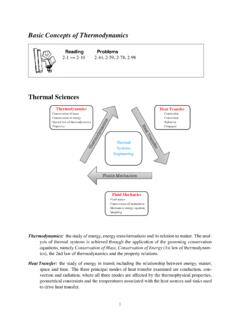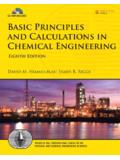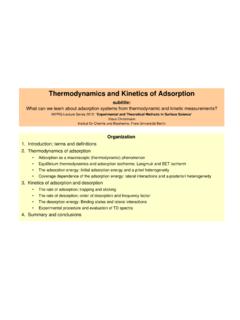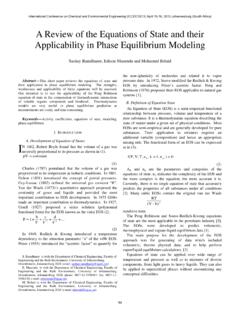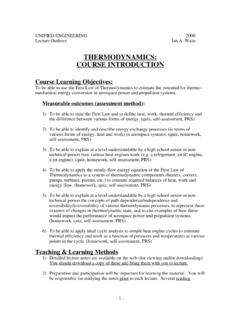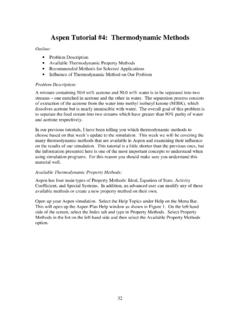Transcription of THERMODYNAMICS PROPERTIES OF PURE SUBSTANCES …
1 THERMODYNAMICS THERMODYNAMICS . PROPERTIES OF PURE SUBSTANCES . Pure Substance A substance that has a fixed chemical composition throughout is called pure substance. Water, helium carbon dioxide, nitrogen are examples. It does not have to be a single chemical element just as long as it is homogeneous throughout, like air. A mixture of phases of two or more substance is can still a pure substance if it is homogeneous, like ice and water (solid and liquid ) or water and steam ( liquid and gas). vapor vapor liquid liquid Water Air (Pure substance) (Not a pure substance because the composition of liquid air is different from the composition of vapor air). Phases of a Pure Substance There are three principle phases solid, liquid and gas, but a substance can have several other phases within the principle phase. Examples include solid carbon (diamond and graphite) and iron (three solid phases). Nevertheless, THERMODYNAMICS deals with the primary phases only.
2 In general: - Solids have strongest molecular bonds. - Solids are closely packed three dimensional crystals. - Their molecules do not move relative to each other - Intermediate molecular bond strength - liquid molecular spacing is comparable to solids but their molecules can float about in groups. - There is molecular order within the groups - Weakest molecular bond strength. - Molecules in the gas phases are far apart, they have no ordered structure - The molecules move randomly and collide with each other. - Their molecules are at higher energy levels, they must release large amounts of energy to condense or freeze. THERMODYNAMICS 1 PROPERTIES OF PURE SUBSTANCES . THERMODYNAMICS Phase Change Processes Of Pure SUBSTANCES At this point, it is important to consider the liquid to solid phase change process. Not so much solid to liquid because THERMODYNAMICS deals only with liquid to gases (or vice versa) to generate power.
3 Consider water at room temperature (20 C) and normal atmospheric pressure (1 atm) in a piston-cylinder device. The water is in liquid phase, and it is called compressed liquid or subcooled liquid (not about to vaporize). Compressed liquid liquid (Point 1). If we add heat to water, its temperature will increase; let us say until 50 C. Due to the increase in temperature, the specific volume v will increase. As a consequence, the piston will move slightly upward therefore maintaining constant pressure (1 atm). Compressed liquid liquid Now, if we continue to add heat to the water, the temperature will increase further until 100 C. At this point, any additional addition of heat will vaporize some water. This specific point where water starts to vaporize is called saturated liquid . (Point 2). THERMODYNAMICS 2 PROPERTIES OF PURE SUBSTANCES . THERMODYNAMICS liquid Saturated liquid If we continue to add heat to water, more and more vapor will be created, while the temperature and the pressure remain constant (T = 100 C and P.)
4 = 1 atm). The only property that changes is the specific volume. These conditions will remain the same until the last drop of liquid is vaporized. At this point, the entire cylinder is filled with vapor at 100 C. This state is called saturated vapor (Point 4). The state between saturated liquid (only liquid ) and saturated vapor (only vapor ) where two phases exist is called saturated liquid - vapor mixture. (Point 3). vapor Saturated liquid - vapor liquid mixture . THERMODYNAMICS 3 PROPERTIES OF PURE SUBSTANCES . THERMODYNAMICS Saturated vapor vapor After the saturated vapor phase, any addition of heat will increase the temperature of the vapor , this state is called superheated vapor (Point 5). Figure 3: T-v diagram representing phase change for water at constant pressure. This concept can be applied to pure substance other than water. THERMODYNAMICS 4 PROPERTIES OF PURE SUBSTANCES . THERMODYNAMICS Saturation Temperature And Saturation Pressure Recall that during a phase change, pressure and temperature are not independent intensive PROPERTIES .
5 As a consequence, the temperature at which water starts boiling depends on the pressure. In other words, water starts boiling at 100 C but only at 1 atm. At different pressures, water boils at different temperatures. At a given pressure, the temperature at which a pure substance changes phase is called the saturation temperature (Tsat). Likewise, at a given temperature, the pressure at which a pure substance changes phase is called the saturation pressure (Psat). Property Diagrams for Phase Change Processes T-v Diagram If we increase the pressure of water in the piston-cylinder device, the process from compressed liquid to superheated vapor will follow a path that looks like the process for P = 1 atm, the only difference is that the width of the mixture region will be shorter. Then, at a certain pressure, the mixture region will be represented only by one point. This point is called the critical point.
6 It is defined as the point at which the saturated liquid and saturated vapor states are identical. At the critical point, the PROPERTIES of a substance are called critical PROPERTIES (critical temperature (Tcr), critical pressure (Pcr) and critical specific volume (vcr)). Example Water Pcr = MPa Tcr = C = K. vcr = m3/kg Air Pcr = MPa Tcr = C = K. vcr = m3/kg THERMODYNAMICS 5 PROPERTIES OF PURE SUBSTANCES . THERMODYNAMICS Figure 4: T-v diagram. If we connect all the points representing saturated liquid we will obtain the saturated liquid line. If we connect all the points representing saturated vapor we will obtain the saturated vapor line. The intersection of the two lines is the critical point. Figure 5: T-v diagram and saturation lines. THERMODYNAMICS 6 PROPERTIES OF PURE SUBSTANCES . THERMODYNAMICS P-v Diagram If we consider the pressure-cylinder device, but with some weights above the piston, if we remove the weights one by one to decrease the pressure, and we allow a heat transfer to obtain an isothermal process, we will obtain one of the curves of the P-v diagram.
7 Figure 6: P-v diagram. The P-v diagram can be extended to include the solid phase, the solid- liquid and the solid- vapor saturation regions. As some SUBSTANCES , as water, expand when they freeze, and the rest (the majority) contracts during freezing process, we have two configurations for the P-v diagram with solid phase. THERMODYNAMICS 7 PROPERTIES OF PURE SUBSTANCES . THERMODYNAMICS Figure 7: P-v diagram for a substance that contracts during freezing (left). and for a substance that expends during freezing (right). Triple point Until now, we have defined the equilibrium between two phases. However, under certain conditions, water can exist at the same time as ice (solid), liquid and vapor . Theses conditions define the so called triple point. On a P-T diagram, these conditions are represented by a point. Example Water T = C = K and P = kPa Figure 8: P-T diagram and the triple point. The P-T diagram is often called the phase diagram since all three phases are separated by three lines.
8 Solid vapor sublimation Solid liquid melting liquid vapor vaporization THERMODYNAMICS 8 PROPERTIES OF PURE SUBSTANCES . THERMODYNAMICS P-T-v Diagram Figure 9: P-T-v diagram for a substance that contracts during freezing (left) and for a substance that expends during freezing (right). Property Tables In addition to the temperature, pressure, and specific volume data, tables contain data for the specific internal energy u, the specific enthalpy h, and the specific entropy s. In THERMODYNAMICS analysis, we will encounter the combination of PROPERTIES U + PV frequently. For simplicity this combination is defined as a new property called enthalpy. H U PV (kJ). The enthalpy per unit mass is h u Pv (kJ/kg). THERMODYNAMICS 9 PROPERTIES OF PURE SUBSTANCES . THERMODYNAMICS Saturated Water Tables Since temperature and pressure are dependent PROPERTIES using the phase change, two tables are given for the saturation region.
9 Table A-4 has temperature as the independent property; Table A-5 has pressure as the independent property. These two tables contain the same information. TABLE A-4. Saturated water-Temperature table The last entry is the critical point at oC. TABLE A-5. Saturated water-Pressure table The last entry is the critical point at MPa. The subscript fg used in Tables A-4 and A-5 refers to the difference between the saturated vapor value and the saturated liquid value region. That is, u fg u g u f h fg hg h f s fg s g s f The quantity hfg is called the enthalpy of vaporization (or latent heat of vaporization). It represents the amount of energy needed to vaporize a unit of mass of saturated liquid at a given temperature or pressure. THERMODYNAMICS 10 PROPERTIES OF PURE SUBSTANCES . THERMODYNAMICS Quality and Saturated liquid - vapor Mixture Now, let's review the constant pressure heat addition process for water shown in Figure 3 (pg 4).
10 Since state 3 is a mixture of saturated liquid and saturated vapor , how do we locate it on the T-v diagram? To establish the location of state 3 a new parameter called the quality x is defined as: mass of saturated vapor mg x . total mass m f mg The quality is zero for the saturated liquid and one for the saturated vapor ( 0 x 1 ). The average specific volume at any state 3 is given in terms of the quality as follows. Consider a mixture of saturated liquid and saturated vapor . The liquid has a mass mf and occupies a volume Vf. The vapor has a mass mg and occupies a volume Vg. We note V V f Vg m m f mg V mv, V f m f v f , Vg mg v g mv m f v f mg v g mf vf mg vg v . m m THERMODYNAMICS 11 PROPERTIES OF PURE SUBSTANCES . THERMODYNAMICS Using the definition of the quality x mg mg x . m m f mg Then mf m mg 1 x m m Note, quantity 1- x is often given the name moisture. The specific volume of the saturated mixture becomes v 1 x v f x v g The form that we use most often is v v f x vg v f.











